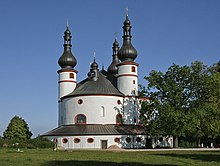Holy Trinity Church Kappl
The Dreifaltigkeitskirche Kappl (also Kappel , von Kapelle ; pilgrimage church of the Holy Trinity ), one of the strangest church creations in Germany, stands in the saddle hollow between the Glasberg and the Dietzenberg in the Waldsassen district of Kappel at 599 m above sea level. NN . In the baroque central building , built 1685–1689 according to plans by Georg Dientzenhofer , the divine trinity is represented as an architectural symbol. The number three dominates in all components. In the exterior, the idea of the Trinity is symbolized in the three towers and the three ridge turrets with onion domes.
history
The Trinity Chapel stands on the former monastery area of the immediately imperial Cistercian Abbey of Waldsassen and was incorporated into it . The oldest previous building was built under Abbot Daniel in the second half of the 12th century to contain an image of the Trinity that had been attached to a tree by a lay brother and was soon considered to be miraculous.
The Hussite Wars , the Landshut War of Succession , the Reformation - secularization of the Waldsassen Monastery between 1571 and 1669 - and the Thirty Years War brought destruction and decay and multiple restoration of the chapel. Even before the re-Catholicization , a new, modest chapel was built in the 1640s after the sick had been cured. After the restoration of the prince abbey, the current Trinity Church with its original symbolic form was built parallel to the new construction of the abbey building - also headed by Georg Dientzenhofer. Dientzenhofer died in 1689, shortly before the building was completed. The solemn church consecration took place in 1711 by the Regensburg auxiliary bishop Albert Ernst von Wartenberg .
Furnishing
The idea of the Trinity also appears in the church furnishings . The interior is formed by three cones , which are placed around an imaginary equilateral triangle. Three hemispheres arch over the three altars and three columns stand in the three corners of the floor plan. The three ceiling paintings were created by Oskar Martin-Amorbach in the years 1934–1940 in a modeled Baroque style after the original Baroque frescoes were destroyed by a fire in 1880.
organ
From 1734 to 1738 an organ with twelve registers on two manuals and pedal was built by the four Bohemian organ builders Joh. Franz Fasmann , David Schmidt, Hans A. Pleyer and Leopold Goll from Elbogen. Eight of the twelve registers have been preserved in the original (marked with an o in the directory), four were rebuilt in 2020 based on the historical model (marked +). The short octave was standard in the Upper Palatinate and Bohemian organ building of the time. The number three is often found on the organ: It is based on three wall pillars, the gallery shell has three fields, as are the parapets on the left and right. It has three works (2 manuals and pedal) with 2 * 333 = 666 pipes, the positive three registers, the prospectus three towers, three fields each are to the right and left of the central tower. There are three figures on the towers (faith (centered with the cross), hope and love, the latter with atypical attributes). In 2020 a restoration took place by Dlabal & Mettler from Bílsko CZ, the consecration was on July 26th, 2020. The disposition from 1738:
|
|
|
||||||||||||||||||||||||||||||||||||||||||||||||
Bells
After the old bells had been destroyed by the fire in the Holy Trinity Church in Kappl in 1880, the bell founder Anton Spannagl made a new ring from three bells with the tone sequence f 1 , g 1 , a 1 . The big bell had to be delivered for war purposes during World War II. It was melted down. In 1968 the Perner bell foundry in Passau cast a new bell with a c 2 strike tone as a replacement . The three bells are distributed across the three towers.
|
No. |
Surname |
Casting year |
Foundry, casting location |
Diameter (mm) |
Mass (kg, approx.) |
Chime |
| 1 | Joseph Bell | 1880 | Anton Spannagl, Regensburg | 972 | 520 | g 1 |
| 2 | Trinity Bell | 1880 | Anton Spannagl, Regensburg | 884 | 380 | a 1 |
| 3 | Marienbell | 1968 | Bell foundry Rudolf Perner, Passau | 795 | 310 | c 2 |
literature
- Hermann Fischer: The organ of the Kappl pilgrimage church . In: Bernhard Eckstein (Red.): History of the former municipality of Münchenreuth. Contributions to the history of the former political community, the parish, the families and farms, the associations. Community chronicle Münchenreuth . Förderverein Vereinsheim Münchenreuth, Münchenreuth 2008, pp. 89–90.
- Robert Treml: The Kapplkirche, pilgrimage church to the Holy Trinity . In: Bernhard Eckstein (Red.): History of the former municipality of Münchenreuth. Contributions to the history of the former political community, the parish, the families and farms, the associations. Community chronicle Münchenreuth . Förderverein Vereinsheim Münchenreuth, Münchenreuth 2008, pp. 79–88.
- Dietmar Herrmann: 300 years ago - the Kapplkirche near Waldsassen was consecrated . In: Der Siebenstern 2011, ISSN 0949-4685 , p. 135
Web links
- Kappl website with a history
- Aerial photos of the pilgrimage church
- Many pictures of the Trinity Church Kappl from inside and outside
- The chimes of the Kappl on YouTube
Coordinates: 50 ° 1 ′ 44 ″ N , 12 ° 16 ′ 37 ″ E










